Allostatic overload - Study guides, Class notes & Summaries
Looking for the best study guides, study notes and summaries about Allostatic overload? On this page you'll find 131 study documents about Allostatic overload.
Page 4 out of 131 results
Sort by
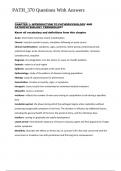
-
PATH_370 Questions With Answers.
- Exam (elaborations) • 51 pages • 2023
-
- $3.49
- + learn more
PATH_370 Questions With Answers. Know all vocabulary and definitions from this chapter Acute: short-lived; may have severe manifestation Chronic- may last months to years, sometimes following an acute course Clinical manifestations- symptoms, signs, syndrome, latent period, prodromal period, subclinical stage, acute clinical course, chronic clinical course, exacerbation, remission, convalescence, sequelae Diagnosis- the designation as to the nature or cause of a health p...
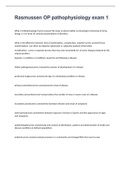
-
Rasmussen OP pathophysiology exam 1 2022/2023 with 100% correct answers
- Exam (elaborations) • 15 pages • 2022
- Available in package deal
-
- $10.49
- + learn more
What is Pathophysiology? The study of abnormalities in physiologic functioning of living beings. it is in terms of common presentations of disorders. What is the difference between clinical manifestation, complication, sequela? Clinical manifestations- can either be objective (physician) or subjective (patient) information Complication- a new or separate process that may arise secondarily b/c of some change produced by the original problem. Sequela- a condition or conditions caused by...
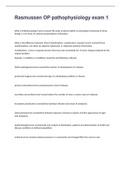
-
Rasmussen OP pathophysiology exam 1 2022/2023 with 100% correct answers
- Exam (elaborations) • 15 pages • 2022
- Available in package deal
-
- $10.49
- + learn more
What is Pathophysiology? The study of abnormalities in physiologic functioning of living beings. it is in terms of common presentations of disorders. What is the difference between clinical manifestation, complication, sequela? Clinical manifestations- can either be objective (physician) or subjective (patient) information Complication- a new or separate process that may arise secondarily b/c of some change produced by the original problem. Sequela- a condition or conditions caused by...
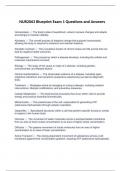
-
NUR2063 Blueprint Exam 1 Questions and Answers
- Exam (elaborations) • 2 pages • 2024
-
- $9.39
- + learn more
NUR2063 Blueprint Exam 1 Questions and Answers Homeostasis -: The body's state of equilibrium, where it senses changes and adapts accordingly to maintain stability. Allostasis -: The overall process of adaptive change that supports homeostasis, allowing the body to respond to stressors and maintain balance. Allostatic overload -: The cumulative burden of chronic stress and life events that can lead to negative health outcomes. Pathogenesis -: The process by which a disease d...
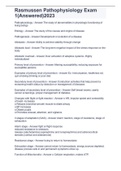
-
Rasmussen Pathophysiology Exam 1(Answered)2023
- Exam (elaborations) • 6 pages • 2023
- Available in package deal
-
- $10.99
- + learn more
Rasmussen Pathophysiology Exam 1(Answered)2023
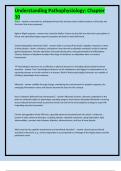
-
Understanding Pathophysiology: Chapter 10
- Exam (elaborations) • 6 pages • 2024
-
- $8.99
- + learn more
Telomere shortening or attrition is linked to biologic aging and can be accelerated by a number of conditions associated with: - answer-inflammation and oxidative stress T/F Stress has a minor role on telomere shortening - answer-False; Stress has a major role on telomere shortening that can begin in utero by increasing early telomere damage, inflammation, and greater rate of leukocyte division T/F Childhood stress predicts telomere erosion and heightened inflammatory repsonse to psychosoc...

-
PATHOPHYSIOLOGY (PATHO) 370 FINAL EXAM STUDY GUIDE 2023 COMPLETE
- Exam (elaborations) • 58 pages • 2023
- Available in package deal
-
- $15.49
- + learn more
PATHOPHYSIOLOGY (PATHO) 370 FINAL EXAM STUDY GUIDE 2023 COMPLETE. Considerations: culture, age, gender, situation, time. 9. Levels of Prevention: Primary: altering susceptibility or reducing exposure for susceptible persons (vaccination). Secondary: early detection, screening, and management of disease. Tertiary: rehabilitation, supportive care, reducing disability, and restoring effective functioning. 10.Subclinical: disease that has no recognizable clinical findings. Distinct from a clini...
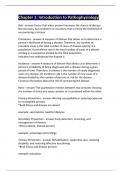
-
Chapter 1: Introduction to Pathophysiology
- Exam (elaborations) • 31 pages • 2023
-
- $12.49
- + learn more
Risk - answer-Factor that when present increases the chance of disease Not stressors, but conditions or situations that increase the likelihood of encountering a stressor Prevalence - answer-A measure of disease that allows us to determine a person's likelihood of having a disease. Therefore, the number of prevalent cases is the total number of cases of disease existing in a population. A prevalence rate is the total number of cases of a disease existing in a population divided by the to...

-
PATHOPHYSIOLOGY (PATHO) 370 FINAL EXAM STUDY GUIDE 2023 COMPLETE
- Exam (elaborations) • 58 pages • 2023
- Available in package deal
-
- $18.49
- + learn more
PATHOPHYSIOLOGY (PATHO) 370 FINAL EXAM STUDY GUIDE 2023 COMPLETE. Etiology: study of causes or reasons for a particular injury. Idiopathic (unknown) vs Iatrogenic (unintended/unwanted medical treatment). Risk Factor: a factor that increases the likelihood of disease. 2. Pathogenesis: development or evolution of disease from initial stimulus to ultimate expression of manifestations of the disease. 3. Clinical Manifestations: Signs (objective) vs Symptoms (subjective). 4. Stages and Clinical ...
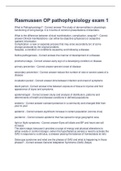
-
Rasmussen OP pathophysiology exam 1 with 100% Correct Answers 2023
- Exam (elaborations) • 12 pages • 2023
- Available in package deal
-
- $10.49
- + learn more
What is Pathophysiology? - Correct answer-The study of abnormalities in physiologic functioning of living beings. it is in terms of common presentations of disorders. What is the difference between clinical manifestation, complication, sequela? - Correct answer-Clinical manifestations- can either be objective (physician) or subjective (patient) information Complication- a new or separate process that may arise secondarily b/c of some change produced by the original problem. Sequela- a con...

Do you wonder why so many students wear nice clothes, have money to spare and enjoy tons of free time? Well, they sell on Stuvia! Imagine your study notes being downloaded a dozen times for $15 each. Every. Single. Day. Discover all about earning on Stuvia


